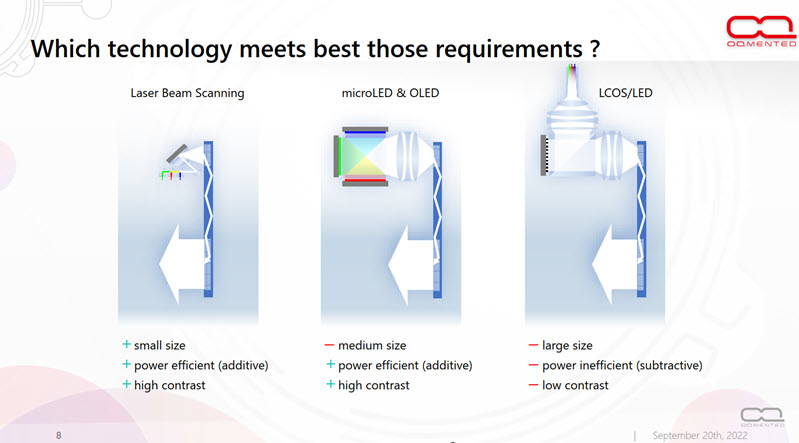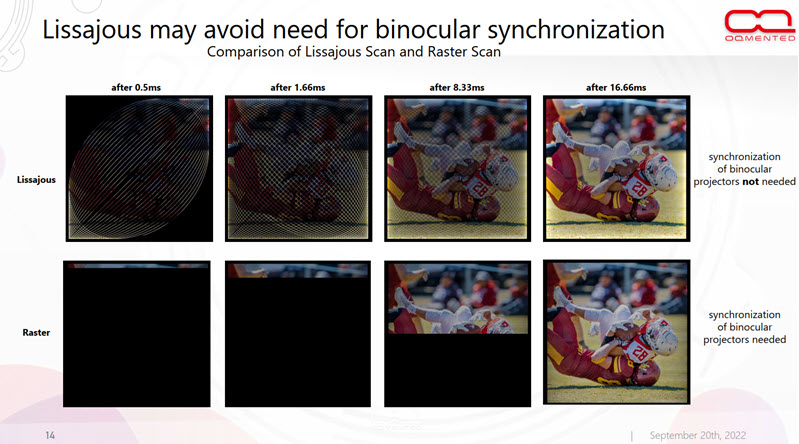The first invited speaker to the DSCC AR & VR forum (DSCC AR & VR Virtual Event – Chansin Looks at the Big Picture) was Ulrich Hofmann of OQmented, a spin-off from the Fraunhofer for Silicon Technology that is developing MEMs-based laser beam scanning (LBS) displays.

The firm has 75 employees and 50+ licensed patents and started in 2018.
Today, everybody is used to using smartphones to consume information, but this is not ideal – smartphone displays are small. In the future there should be a fusion of the digital and real worlds. 2D is interesting but even more interesting are the possibilities for 3D. The challenge though is there are no consumer AR products to provide volume. Magic Leap and Microsoft have products but they are only for professionals as they have a lot of disadvantages. They change the appearance of the user and you can’t get good eye contact. The battery life is also short.
The focus is on miniaturisation and integration, efficiency boosting and optical efficiency and performance for the development of fashionable glasses that would appeal to consumers. That’s a challenge for indoor and outdoor use. There are several candidate displays, LBS, microOLED and microLEDs and LCOS/LCD. LBS does need any optics behind the display, so it can be very small.
LCOS/LED is very inefficient because it is subtractive – you have to have the backlight on all the time. Hofmann believes that microOLED is challenged to meet the brightness requirement. However, they also all have advantages so it remains to be seen what will win.
Looking at LBS, the Hololens has quite a bulky optical system because of the use of two large chips – one for the fast horizontal scanning and the other for the slow vertical scanning. OQmented can control the deflection on both axes with a single chip and can even be smaller than the graphic, although it has almost the performance of the Hololens. The architecture is optimised so that almost the whole are of the device can be used as a mirror with little space used for suspension and actuators. That artchitecture is patented. Both axes are operated in resonance to minimise the power consumption. Small forces can have a big impact if applied at the right frequency.
The mirror is also encapsulated in a vacuum enclosure to conserve as much of the deflection energy as possible. The firm also has a tiny CMOS driver chip and OQmented can use just 10mW for the MEMS device and driver chip.
The vacuum also helps with field of view and allows up to a 10X increase in deflection for a wider field of view. The device uses a sinusoidal image generation technique which is patented as Lissajous addressing. This may mean that there is less need for binocular synchronisation as the image is not drawn from top to bottom with the whole area gradually being produced.
High contrast and high brightness images can be shown at high resolution. The firm is collaborating with Dispelix to ensure that integration with the firm’s waveguides is straightforward.
Text projection is going to be important in AR and the firm has done a lot of work to ensure legibility. The firm’s technology can achieve 14 cycles per degree with 30% MTF (so 28 pixels/degree) and it can achieve a FOV of 50 xx 30 which is equivalent to 1400 x 800 pixels. At at 28 x 14, the current limit based on current waveguides, you can create 800 x 400 resolution.
The technology can be scaled to cover 100 x 50 – 3,000 pixels per line and that is not the end as you could add additional laser sources.
The firm has a stand-alone demonstrator that it plans to show later this year and will include all the electronics in a pair of glasses. The main circuits are at the furthest distance from the user on the corners of the glasses. The devices will be developed to support RGB use and binocular glasses.
Chansin asked whether there had been some disappointment with LBS because of the Hololens product development. Hofmann said that there had been a lot of expectations for microLED, but the issues of scalability of efficiency have not yet been sold and there are other issues in yield and cost. The systems do not get small enough, he said, and that is why he is confident about LBS technology. Lasers are a great source of light but can still be improved.
In response to a question about safety, Hofmann said that there could be a problem if you are trying to direct the beam into the eye, the reality of LBS is that the waveguide destroys the coherence, so the light in the eye is not laser light.




